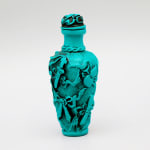Chinese Snuff Bottle, Twentieth Century AD
Lacquered Wood
9 x 4 cm
3 1/2 x 1 5/8 in
3 1/2 x 1 5/8 in
CC.102
Further images
-
(View a larger image of thumbnail 1
)

-
(View a larger image of thumbnail 2
)

-
(View a larger image of thumbnail 3
)

-
(View a larger image of thumbnail 4
)

-
(View a larger image of thumbnail 5
)

-
(View a larger image of thumbnail 6
)

-
(View a larger image of thumbnail 7
)

-
(View a larger image of thumbnail 8
)

-
(View a larger image of thumbnail 9
)

-
(View a larger image of thumbnail 10
)

-
(View a larger image of thumbnail 11
)

Tobacco was introduced to the Ming Imperial Court by the Portuguese, sometime in the Sixteenth Century AD. At that time, the Chinese upper classes, like their contemporaries in Europe, smoked...
Tobacco was introduced to the Ming Imperial Court by the Portuguese, sometime in the Sixteenth Century AD. At that time, the Chinese upper classes, like their contemporaries in Europe, smoked tobacco from long clay pipes. In AD 1644, however, the Ming gave way to the Qing, a new Dynasty from Manchuria in the north. The Manchus had developed their own tobacco habits separately from the Chinese, focused around the snorting of powdered tobacco, known as snuff. The Qing made the smoking of tobacco illegal, but allowed the snorting of snuff as it was considered to have medicinal properties: it was a remedy for illnesses as diverse as the common cold, headaches and stomach complaints. Storing snuff in the humid environment of China was, however, a challenge. Snuff stored in boxes, as in Europe, often caked as a result of the moisture in the air. The solution, from about the Eighteenth Century AD, was to store snuff in bottles, which could be sealed tightly against the elements. Decorated snuff bottles became a characteristic Chinese handicraft, and a status-symbol for elite Qing men.
This busy decorated snuff bottle has a circular foot which rises to a squarish profile at the shoulder, with a slender neck and a domed stopper. The body of the bottle is decorated in high relief, with a series of accoutrements associated with the upper classes: a sword, a set of keys, a bamboo flute, a calligraphy bottle and pen, a fan, a basket of fruit and some kind of pot with tall right-angled uprights rising from it. Between these are the sinuous tendrils of the lotus, with a spectacular flower at the bottom of the vessel. The pot has a chain pattern around the neck, and the domed stopper has multiple tendrils wrapped around it. The stopper is cork, and has no spoon for portioning out snuff, and so this bottle was likely never used for snuff at all, but rather was created as a decorative item for export.
Snuff bottles have considerable charm. Made to be handled, they often have a pleasant, tactile quality. Their decoration ranges from the fanciful to the highly symbolic, from the plain to the ornate. As a result, snuff bottles have been a persistent Chinese export to Europe, and Western collectors have demonstrated an abiding interest right from the Eighteenth Century AD, when the taste for chinoiserie was at its height. Resultantly, there are a dwindling number of original bottles on the market.
This busy decorated snuff bottle has a circular foot which rises to a squarish profile at the shoulder, with a slender neck and a domed stopper. The body of the bottle is decorated in high relief, with a series of accoutrements associated with the upper classes: a sword, a set of keys, a bamboo flute, a calligraphy bottle and pen, a fan, a basket of fruit and some kind of pot with tall right-angled uprights rising from it. Between these are the sinuous tendrils of the lotus, with a spectacular flower at the bottom of the vessel. The pot has a chain pattern around the neck, and the domed stopper has multiple tendrils wrapped around it. The stopper is cork, and has no spoon for portioning out snuff, and so this bottle was likely never used for snuff at all, but rather was created as a decorative item for export.
Snuff bottles have considerable charm. Made to be handled, they often have a pleasant, tactile quality. Their decoration ranges from the fanciful to the highly symbolic, from the plain to the ornate. As a result, snuff bottles have been a persistent Chinese export to Europe, and Western collectors have demonstrated an abiding interest right from the Eighteenth Century AD, when the taste for chinoiserie was at its height. Resultantly, there are a dwindling number of original bottles on the market.










